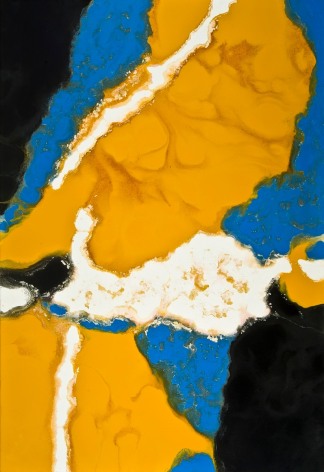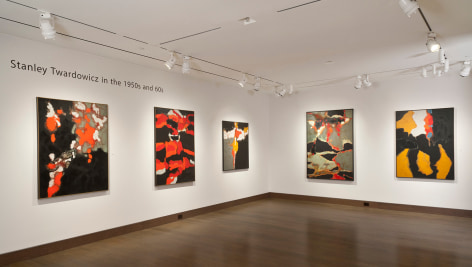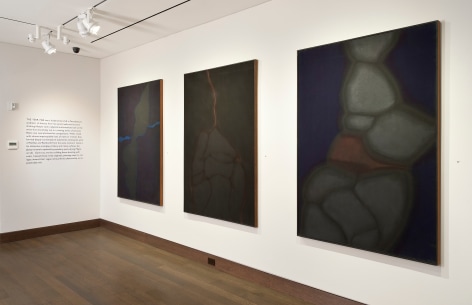
Hirschl & Adler Modern is pleased to announce the opening of Stanley Twardowicz in the 1950s and 60s on Thursday, October 18th, 2012. Stanley Twardowicz (1917-2008), a one-time orphan, Golden Gloves boxer, professional baseball player and auto worker, emerged from a hardscrabble upbringing in Detroit to become a popular and improbable denizen of New York’s Cedar Tavern, the flash pan of Abstract Expressionism in the 1950s.
Twardowicz’s early abstractions were inspired by his close-up observations of nature, particularly his “macro” views of the Maine coast’s weathered rocks, tidal pools, and moss-covered bark. Characterized by a liberal use of black juxtaposed with tough, brooding earth tones jarringly disrupted by flashes of primary color, Twardowicz’ paintings from the ‘50s challenge and exhaust the senses. And yet there is an eerie beauty in them. The strange forms and colors appear oddly familiar, like light bursting through cracks in a dense forest canopy, foamy surf pulled between boulders by the ebb tide, or silted rivers carving through an arid plain.
He landed on the cover of Art in America’s “New Talent Annual, 1958.” It was one highlight of an impressive run that included a 1956 Guggenheim Fellowship, group shows at the Whitney and Guggenheim museums, The Art Institute of Chicago, Carnegie Institute, and The Museum of Modern Art. The latter trumpeted its acquisition of a Twardowicz canvas in 1956 and later bought six of his photographs. In 1958 he signed with New York’s influential Peridot Gallery, and two years later was also showing on the West coast with avant-garde dealer Virginia Dwan who showed him in the company of Norman Bluhm, Philip Guston, Franz Kline, Willem de Kooning, Ray Parker, Jackson Pollock, and Larry Rivers.
By 1960, a divorce from his second wife and his hard-drinking lifestyle took a physical and emotional toll on Twardowicz that would play out in a riveting series of canvases. Black now overwhelmed his compositions. When mixed with almost imperceptible hues of violet or crimson they formed deeply contemplative statements echoing the work of Rothko and Reinhardt from the same moment. Gone is his distinctive interplay of shiny and matte surfaces, the glossy enamels replaced by powdery, quick-drying Magna acrylic. Gone too are the colliding forms bursting with color. Instead these richly enigmatic paintings seem to collapse inward, their vague, sensual forms obscured by an impenetrable veil.
After Peridot closed in 1970, Twardowicz retreated to his teaching at Hofstra University and the quietude of his Northport, Long Island studio. Recoiling at commercialism and unwanted attention, Twardowicz nevertheless became a fixture in the north shore art world, a revered mentor, and longtime board member of the Heckscher Museum in Huntington, New York. He would enjoy four museum retrospectives in his lifetime and repeated accolades for his innovative photography. His works are in the collection of numerous American institutions including, The Butler Institute of American Art, Youngstown, OH; Farnsworth Art Museum, Rockland, ME; Fogg Art Museum, Cambridge, MA; Hirshhorn Museum and Sculpture Garden, Washington, DC; Los Angeles County Museum of Art, CA; Milwaukee Art Museum, WI; Museum of Modern Art, NY; Newark Museum, NJ; the Smithsonian American Art Museum, Washington, DC, and others.
Stanley Twardowicz in the 1950s and 60s opens on Thursday, October 18th and runs through Saturday, November 17, 2012. Located in the landmark Crown Building at the corner of 57th Street and Fifth Avenue, Hirschl & Adler Modern is open Tuesday through Friday, from 9:30 am to 5:15 pm, and Saturdays from 9:30 am to 4:45 pm.
For additional information or images, please contact Thomas B. Parker, Associate Director, Hirschl & Adler Modern, at 212-535-8810 (phone) / 212-772-7237 (fax), or by email at TomP@HirschlAndAdler.com. Please visit our website at www.HirschlAndAdler.com for an online preview of the exhibition.









